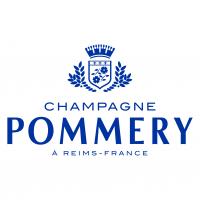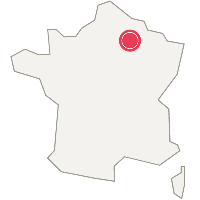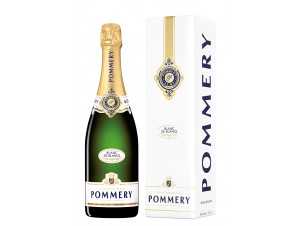You have no items in your shopping cart.
Champagne
Champagne Pommery
(23 customer reviews)
Maison Pommery, like many other Champagne houses, owes its fame and international success to one woman, Madame Pommery, who made this Champagne an exceptional wine, not only by focusing on the quality of the grapes and the terroir, but also by inventing Champagne Brut, thus marking a decisive turning point in the world of Champagne. Find out more
 Recommended by
Recommended byParker Wine Advocate - Bettane et Desseauve avant 2020 - Jancis Robinson
-

Shipped in
secured packaging -

Garantie anti-casse :
Prise en charge totale
The winemaker
Mrs Pommery is behind the revolution in the world of Champagne
Alexandre Louis Pommery, until then a wool merchant, decided to radically change his business in 1856, creating the company Pommery & Gréno with Monsieur Joseph-Narcisse Gréno, also a merchant. This company was dedicated to the production and trade of Champagne. However, Mr. Pommery died prematurely in 1858, and it was then Jeanne-Alexandrine Pommery, his widow, known today as Madame Pommery, who took over the reins of the company, with the help of Mr. Gréno until 1860. She then ran the company alone until 1890, when her son Louis Pommery took over the family business.
The work, or rather revolution, undertaken by Madame Pommery completely transformed the vineyard of Champagne, and the way her House operated inspired many of the greatest producers still known today. Indeed, she was one of the first to realize the importance of grape quality, and so began to buy her own parcels of vines, cultivate them and have them harvested by her company, reaching 65 hectares of vines by the 1890s. That's not all: at the time, champagnes were wines with a high sugar content, to compensate for the acidity of the grapes and thus create sweet sparkling wines. But in 1874, in search of innovation and novelty in taste, Pommery was the first Maison to produce a Champagne Brut, the cuvée Pommery Nature, which was an immediate success.
Madame Pommery also ventures into other, more architectural styles of construction. She had her company's buildings constructed in the English style, particularly unusual in the region at the time, and which adds a further touch of originality to this House. The buildings were also organized in an H-shape, to facilitate future extensions, while reflecting a genuine philosophy of openness to the world and breaking the codes and barriers of this prestigious and rather closed environment. As early as 1868, she had 18 km of pits converted into cellars at depths of over 30 meters, and embarked on what is still known in the region as the "Construction Site of the Century".
The Pommery family kept control of the company via the Polignac family, named after the wife of Louis Pommery, son of Madame Pommery, until 1979, when the company changed hands several times before being bought by the LVMH group in 1991. But in 2002, the company changed hands once again, being bought by the Vranken Monopole group and becoming Vranken-Pommery Monopole.
The style of Pommery champagnes remains preserved over time
These various changes have not, however, allowed the House's philosophy to be lost. The style sought in the cuvées produced remains natural. Since 2014, the vines are grown with respect for the environment, and the estate has 2 labels: HVE (high environmental value) and "Viticulture Durable en Champagne". Champagnes are still made according to the methode traditionnelle champenoise that had been established by Madame Pommery, where the grapes have the greatest opportunity to express themselves. Today, Clément Pierlot, Chef de Cave, is in charge of the assemblage, along with the House's oenologists.
Madame Pommery's cellars are still used to store the wines and age them for several months (the number varies according to the cuvées) so that the aromas can develop at their best, and the wine can begin a second fermentation in bottle, which results in the prise de mousse: once the yeasts have consumed all the sugar to transform it into alcohol and CO2, they die in the bottle, offering all the more aromas to the wines. It is then essential to remove the lees, which form a cork at the top of the bottle, which has been placed at the bottom. The bottle is then disgorged, allowing the natural cork of lees to be expelled, and filled with "liqueur d'expédition", a mixture of sugar and reserve wine. The wine can then be sold, or kept in the cellar to age.
The flagship vintages of Pommery champagnes
Today, there are 14 cuvées in the Pommery range, grouped under 4 different cuvée names, then declined: POP, Brut, Louise and Clos Pompadour.
Mme Pommery is behind the revolution in the world of champagne
.Alexandre Louis Pommery, until then a wool merchant, decided to radically change his activity in 1856, creating the company Pommery & Gréno with Monsieur Joseph-Narcisse Gréno, also a merchant. This company was dedicated to the production and trade of Champagne. However, Mr. Pommery died prematurely in 1858, and it was then Jeanne-Alexandrine Pommery, his widow, known today as Madame Pommery, who took over the reins of the company, with the help of Mr. Gréno until 1860. She then ran the company alone until 1890, when her son Louis Pommery took over the family business.
The work, or rather revolution, undertaken by Madame Pommery completely transformed the vineyard of Champagne, and the way her House operated inspired many of the greatest producers still known today. Indeed, she was one of the first to realize the importance of grape quality, and so began to buy her own parcels of vines, cultivate them and have them harvested by her company, reaching 65 hectares of vines by the 1890s. That's not all: at the time, champagnes were wines with a high sugar content, to compensate for the acidity of the grapes and thus create sweet sparkling wines. But in 1874, in search of innovation and novelty in taste, Pommery was the first Maison to produce a Champagne Brut, the cuvée Pommery Nature, which was an immediate success.
Madame Pommery also ventures into other, more architectural styles of construction. She had her company's buildings constructed in the English style, particularly unusual in the region at the time, and which adds a further touch of originality to this House. The buildings were also organized in an H-shape, to facilitate future extensions, while reflecting a genuine philosophy of openness to the world and breaking the codes and barriers of this prestigious and rather closed environment. As early as 1868, she had 18 km of pits converted into cellars at depths of over 30 meters, and embarked on what is still known in the region as the "Construction Site of the Century".
The Pommery family kept control of the company via the Polignac family, named after the wife of Louis Pommery, son of Madame Pommery, until 1979, when the company changed hands several times before being bought by the LVMH group in 1991. But in 2002, the company changed hands once again, being bought by the Vranken Monopole group and becoming Vranken-Pommery Monopole.
The style of Pommery champagnes remains preserved over time
.These various changes have not, however, allowed the House's philosophy to be lost. The style sought in the cuvées produced remains naturalness. Since 2014, the vines are grown with respect for the environment, and the estate has 2 labels: HVE (high environmental value) and "Viticulture Durable en Champagne". Champagnes are still made according to the methode traditionnelle champenoise that had been established by Madame Pommery, where the grapes have the greatest opportunity to express themselves. Today, Clément Pierlot, Chef de Cave, is in charge of the assemblage, along with the House's oenologists.
Madame Pommery's cellars are still used to store the wines and age them for several months (the number varies according to the cuvées) so that the aromas can develop at their best, and the wine can begin a second fermentation in bottle, which results in the prise de mousse: once the yeasts have consumed all the sugar to transform it into alcohol and CO2, they die in the bottle, offering all the more aromas to the wines. It is then essential to remove the lees, which form a cork at the top of the bottle, which has been placed at the bottom. The bottle is then disgorged, allowing the natural cork of lees to be expelled, and filled with "liqueur d'expédition", a mixture of sugar and reserve wine. The wine can then be sold, or kept in the cellar to age.
The flagship vintages of Pommery champagnes
Today, there are 14 cuvées in the Pommery range, grouped under 4 different cuvée names, then declined: POP, Brut, Louise and Clos Pompadour.
Pommery - POP Cuvées
Available in 4 cuvées, POP cuvées are only available in 20 cl bottles. POP cuvée is a blend of Pinot Noir, Pinot Meunier and Chardonnay, POP Rose is a champagne rosé, POP Argent is full of spirit, and POP Or Millésime 2008 is a vintage cuvée, complete and complex, with aromas of white flowers and eau de vie.Pommery - Les cuvées Brut
The cuvée Brut Royal is the signature of Maison Pommery, an elegant, lively and harmonious palate, it's also available in rosé, thanks to a blend with red wine, vinified with Pinot Noir, it's a very subtle rosé, very lively and fresh. Cuvée Blanc de Blancs is, as its name suggests, made only from Champagne's only white grape variety: Chardonnay. The nose gives off lovely notes of acacia and jasmine, the palate is very balanced, fruity and floral. The Brut Apanage, which ages in the cellar 6 months longer than the other cuvées, develops notes of dried fruit and vanilla, this is the House's gastronomic Champagne. Next, the Brut Millésimé 2008 marks this superb Champagne year, with a soft mouthfeel, even reminiscent of blood orange. The range is completed by Royal Blue Sky, which is no longer a Brut, but rather a sweeter champagne, to be enjoyed on the rocks, to rediscover the tastes and sensations of the champagnes of yesteryear.Pommery - Les Cuvées Louise
The Cuvée Louise 2004, crafted as a tribute to Louise Pommery, from grapes sourced exclusively from 3 Champagne grands crus: Avize, Aÿ and Cramant. It's a very buttery wine, with gourmet cookie notes. Cuvée Louise Nature 2004 is made in the same way as Cuvée Louise, but without any sugar, a tighter alternative, but still just as gourmand. Last but not least, Cuvée Louise Rosé 2004 completes the range, with a rosé champagne blended with a red wine, bringing a lot of tenderness to this cuvée.Pommery - Les Clos Pompadour
The House's most exclusive cuvee, this cuvée is only available in magnum, to highlight its exceptionality. Produced from 25 hectares of vines within Maison Pommery, this champagne exudes magnificent notes of citrus and white flowers, the palate is full and very long, fresh and complex.
Registered since 22/07/2020

5 Place du Général Gouraud BP 1049,
51100 REIMS CEDEX 2
51100 REIMS CEDEX 2

5 wines available
between 45.9 € and 210 €
between 45.9 € and 210 €

153 wine's scans
on Twil application
on Twil application

Best rated wines on Twil :
You might like Voir tous les vins de la région
- -26%
- -27%
- -26%






















 TWIL - Achat de Vin
TWIL - Achat de Vin


